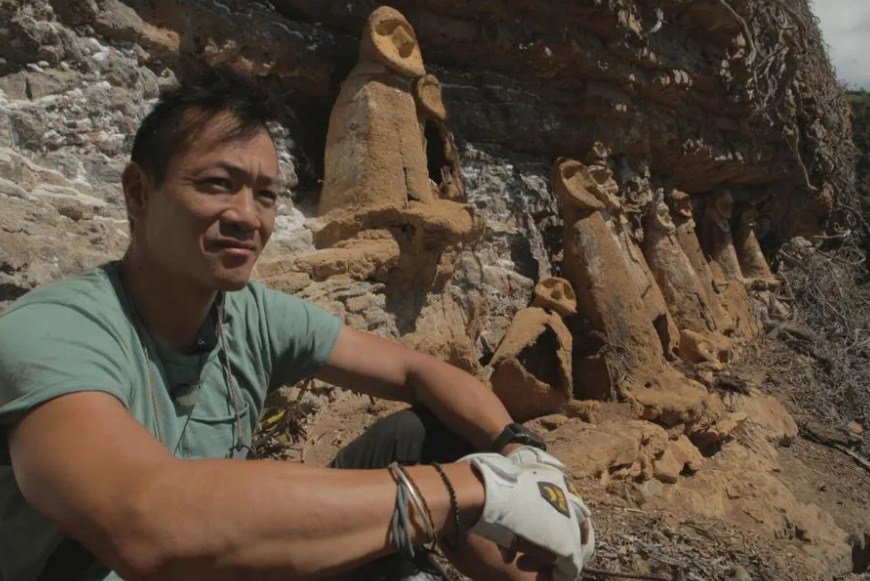Albert Lin is not your typical explorer. He is an engineer, a scientist, and an archaeologist who uses cutting-edge technology to reveal the hidden mysteries of the past. He has hosted several National Geographic shows, such as Lost Cities with Albert Lin and Buried Secrets of the Bible with Albert Lin, where he uses drones, satellites, and LIDAR (light detection and ranging) imaging to uncover ancient structures and civilizations that have been buried for centuries or millennia.
The Quest for Genghis Khan’s Tomb
One of Lin’s most ambitious projects was to search for the tomb of Genghis Khan, the founder of the Mongol Empire who died in 1227 and whose burial place has eluded discovery since. Lin proposed to use remote sensing technology to scan the sacred mountain of Burkhan Khaldun, where the tomb is believed to be located, without disturbing the local culture and beliefs. He received funding from the National Geographic Society and embarked on a groundbreaking expedition that involved ground-penetrating radar, satellite imagery, and crowdsourcing.
Lin and his team scanned over 6,000 square kilometers of terrain and identified over 50 potential sites of interest. They also enlisted the help of over 10,000 online volunteers who analyzed the satellite images and flagged possible anomalies. Lin then visited some of the sites on the ground and found evidence of ancient rituals, such as stone circles, deer stones, and burial mounds. However, he did not find the tomb itself, which remains a mystery to this day.
The Discovery of Lost Cities and Civilizations
Lin’s innovative methods of exploration have also led him to discover and study lost cities and civilizations around the world. In China, he used satellite imagery and LIDAR to map the mausoleum of the First Emperor, who unified China in 221 BC and built the famous Terracotta Army. Lin revealed the complex layout of the mausoleum, which covers an area of 56 square kilometers and contains over 600 pits filled with various artifacts and treasures.
In Guatemala, he used LIDAR to scan the dense jungle and reveal the hidden ruins of the Maya civilization. He found over 60,000 structures, including pyramids, palaces, temples, and fortifications, that had been concealed by the vegetation for centuries. He also found evidence of a complex network of roads, canals, and causeways that connected the Maya cities and supported a population of millions. Lin’s findings challenged the conventional view of the Maya as a peaceful and isolated culture and suggested that they were a sophisticated and warlike civilization that collapsed due to environmental and social factors.
The Search for the Truth Behind the Bible Stories
Lin’s latest adventure is to seek out the truth behind two great stories of the Bible: the parting of the Red Sea and the destruction of Sodom and Gomorrah. To solve these mysteries, Lin uses satellites and space-age technology to look beneath the earth’s surface and reveal secrets that have been buried for thousands of years. He also consults with experts, historians, and local people to gain insights and perspectives on the historical and cultural context of the stories.
In Egypt, Lin investigates the possible routes and locations of the Exodus, the biblical story of how Moses led the Israelites out of slavery in Egypt and crossed the Red Sea. He uses satellite imagery to identify ancient landmarks and pathways that match the biblical descriptions. He also uses LIDAR to scan the bottom of the Red Sea and look for traces of the miraculous event. He finds some intriguing anomalies, such as coral formations and metal objects, that could be related to the Exodus.
In Jordan, Lin explores the possible sites and causes of the destruction of Sodom and Gomorrah, the biblical cities that were obliterated by fire and brimstone for their wickedness. He uses LIDAR to scan the Dead Sea region and look for signs of ancient settlements and cataclysms. He finds several candidates for the location of Sodom and Gomorrah, as well as evidence of a massive meteor impact that could have triggered a devastating explosion and firestorm.
The Future of Exploration and Discovery
Lin’s work is not only a fascinating journey into the past, but also a visionary glimpse into the future of exploration and discovery. He uses technology to augment his human senses and abilities, and to access places and information that would otherwise be impossible or impractical. He also uses technology to collaborate with other experts and enthusiasts, and to share his findings and stories with the world. He believes that technology can empower anyone to become an explorer and a storyteller, and to contribute to the collective knowledge and imagination of humanity.
Lin’s work is also a testament to the enduring curiosity and wonder of the human spirit, and to the value and relevance of the past for the present and the future. He shows that the past is not a static and distant reality, but a dynamic and living source of inspiration and insight. He shows that the past is not only about facts and dates, but also about stories and meanings. He shows that the past is not only about what we know, but also about what we don’t know and what we want to know.
Lin’s work is a space-age journey into the past, and a timeless journey into the self.

